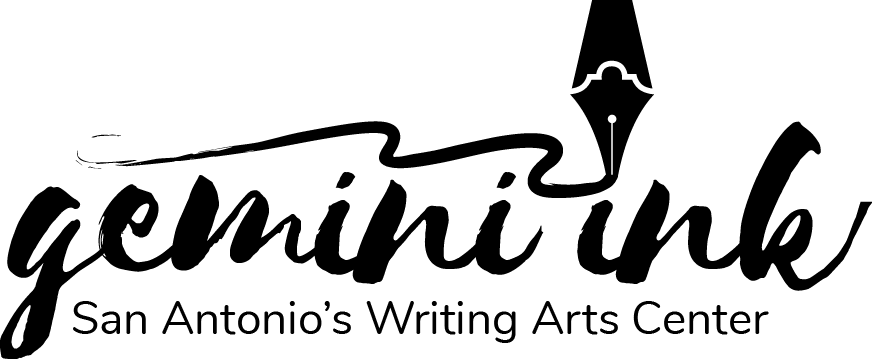The Writer’s Desk features the desks and writing practices of Gemini Ink faculty, visiting authors, teaching artists, volunteers, students, interns, staff, partners and more. Receive new posts in your inbox by subscribing to our newsletter at bit.ly/geminiinknewsletter.
1) Describe your first writing desk. How is it different from your current writing desk?
My first writing desk wasn’t a desk at all. As a child I would stretch out on the carpet of my room and scribble ideas in a spiral notebook. The floor was my imagination’s domain, where the worlds I dreamed up with my toys had free reign; and I felt most comfortable creating there. Now I write either at my kitchen table or on my lounge chair in my room, both next to a bank of windows, both with my dachshund snuggled next to me. When I find myself stuck, I look out at the backyard and soak in the trees and grass and sky arching overhead.
2) How important is it to you to have stability in your writing routine?
Stability is key in my routine. Writing isn’t just about having an idea; it’s about having the discipline to build on that idea daily until you have a complete work. Just as you should head to the gym when you want to stay in bed, you should drag yourself to the page when you’d rather procrastinate with a TV show or the like. As Stephen King says, “Amateurs sit and wait for inspiration; the rest of us just get up and go to work.”
3) What is the one piece of writing advice that you value most?
In high school a teacher told me, “You get the best conflict when what your character wants and what your character is afraid of are the same thing.” I believe conflict is at the heart of good fiction; and when your protagonist is at war with himself or herself, you work with the most elemental, dramatic struggle of all. As I build my characters, I strive to forge them around my teacher’s guideline. For example, many of my protagonists long for the intimacy of love but are terrified of vulnerability and the possibility of getting hurt.
4) What’s a movie that you can watch over and over again and not get tired of?
I’ve seen Alfred Hitchcock’s Rebecca (1940) no fewer than thirty times. My mom first showed it to my sister and me when we were young; and every time I watch it, I notice something new. My perception of the main characters’ relationship, in particular, has shifted dramatically over the years. Layers and hidden meanings saturate the film beyond the twists and turns of the action, and these are what keep me coming back time and time again.
5) What theme or symbol often emerges in your work? Why are you drawn to this theme/symbol?
The struggle to balance self-sufficiency with opening up to others has long fascinated me. I’m drawn to this theme both because I sometimes struggle with this in my own life and because there are so many iterations and scenarios to explore.
6) Do you like things to be carefully planned out, or do you prefer to just go with the flow? Does this also apply to how you lay out a story?
I like things to be carefully planned out, which does apply to how I lay out a story. I don’t like to start writing without a road map. First, I identify what the central conflict of my narrative is and brainstorm different ways I might explore this. At the same time, I build my characters in relation to this theme and clarify their relationships with each other. Once I’ve ironed out the central concepts, I organize the action using the principles of film structure, which emphasize the hero’s journey. Finally, as I come to each chapter, I develop a broad idea of what will happen in that unit before I plunge myself into the narrative.
7) Who are your favorite writers? And who is your favorite hero/heroine in fiction?
My favorite authors are William Gay, Flannery O’Connor, Karen Russell, and Fyodor Dostoevsky. Gay and O’Connor write Southern Gothic works with searing, beautiful language steeped in menace and foreboding. Russell’s similes and metaphors are fresh and creative, and her stories involve intriguingly original subjects like a werewolf’s daughter at a school for integration into “civilized” life. Finally, Dostoevsky’s novels examine the darkest depths of psychology while exploring philosophical ideas like existentialism.
My favorite fictional hero has to be Sydney Carton from A Tale of Two Cities. I won’t spoil it for those who haven’t read the novel, but his tale of sacrifice and redemption is, for me, the most inspiring in all of literature.

Samantha Talley obtained her M.F.A. from the University of Tampa, where she received the Outstanding Student Award, and her Master’s in Teaching from Trinity University. One of her stories was chosen as a Top 10 Finalist (out of 600 entries) for the Screen Craft Short Story Contest. Another story received Special Recognition for AWP’s Kurt Brown Prize. She has attended the New York State Summer Writers Institute and the Sewanee Writers’ Conference.



